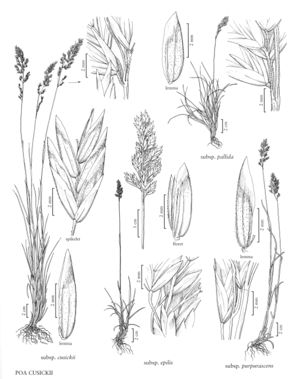Difference between revisions of "Poa cusickii subsp. cusickii"
imported>Volume Importer |
imported>Volume Importer |
||
| Line 44: | Line 44: | ||
|publication year= | |publication year= | ||
|special status=Endemic | |special status=Endemic | ||
| − | |source xml=https://bitbucket.org/aafc-mbb/fna-data-curation/src/ | + | |source xml=https://bitbucket.org/aafc-mbb/fna-data-curation/src/200273ad09963decb8fc72550212de541d86569d/coarse_grained_fna_xml/V24/V24_782.xml |
|subfamily=Poaceae subfam. Pooideae | |subfamily=Poaceae subfam. Pooideae | ||
|tribe=Poaceae tribe Poeae | |tribe=Poaceae tribe Poeae | ||
Latest revision as of 16:25, 11 May 2021
Plants densely tufted. Basal branching intravaginal. Culms 10-60(70) cm, mostly erect, with 0-1 well-exserted nodes. Sheaths closed for 1/4-1/3 their length, distal sheath lengths 3-10 times blade lengths; innovation blades 0.5-1 mm wide; cauline blades less than 1.5 mm wide, flat, folded, or involute, apices narrowly prow-shaped, flag leaf blades (0.5)1.5-5 cm. Panicles usually 5-10(12) cm, contracted or loosely contracted, with 20-100 spikelets; nodes with 1-5 branches; branches 1.7-4(5) cm, slender to stout, moderately to densely scabrous, with 2-15 spikelets. Spikelets 4-10 mm. Calluses glabrous; lemmas 4-7 mm, glabrous; anthers vestigial (0.1-0.2 mm) or 2-3.5 mm. 2n = 28.
Discussion
Poa cusickii subsp. cusickii grows mainly in mesic desert upland and mountain meadows, on and around the Columbia plateaus of northern California, Oregon, southern Washington, and adjacent Idaho and Nevada. It is highly variable, with fairly open- to contracted-panicle populations, and from gynodioecious to dioecious populations. The modal and mean longest branch lengths of the narrower-panicled populations of subsp. cusickii serve to distinguish it from subsp. pallida in most cases. It appears to have hybridized with P. pringlei (p. 564) around Mount Shasta, California, and Mount Rose, Nevada. Poa stebbinsii (p. 564), an endemic in the high Sierra Nevada, is easily distin¬guished from P. cusickii subsp. cusickii by its long hyaline ligules.
Selected References
None.
